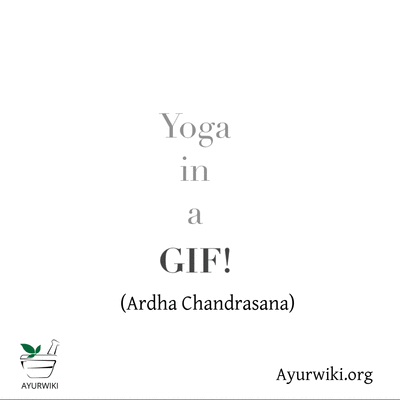Note: This is a project under development. The articles on this wiki are just being initiated and broadly incomplete. You can Help creating new pages.
Ardha Chandrasana
Ardha Chandrasana is derived from the Sanskrit ardha, meaning half, and chandra, meaning moon, and asana meaning seat or posture. This is a graceful, balanced pose which mirrors the image of the half moon in the sky and awakens the opposing sides of the physical body.
Contents
Technique
- First, come into the pose of Trikonasana on your right side and keep your left hand on your left side of the hip.
- After that, inhale, during this gently bent your right knee and try to keep your same foot around 12 inches forward along with keeping your right hand in forwarding direction and keep it apart from your right foot toes.
- Then breathe out and slightly move your right hand to the ground or floor. Press the floor with your right hand. After that, keep your right leg straight. During this raise your alternate leg (left leg) off the floor. Remember that, it’s parallel to the ground.
- Now, try to maintain your balance, at that time don’t lock your right knee. You have to keep your knee cap straight and it does not range inwards.
- Bend your upper trunk (torso) heading your left, and move your left hip part slowly in the straight direction.
- Keep your left hand on your left side of the hip and your head should be in a position of gazing forward.
- Maintain whole body weight on the leg in which you are standing on.
- Press the floor by your lower hand it will help you to gain the balance.
- Make sure you firmly push the scapulas and sacrum against the back of your torso.
- Ensure you solidly drive the scapulas and sacrum against the back of your trunk (torso).
- Remain in the pose for a few seconds. After that put down your left leg down to the floor and come to your initial position. Repeat the same process on the opposite side.[1]
Effects
- Strengthens your legs, ankles, abdomen, buttocks and spine
- Stretches your groins, hamstrings, calves, shoulders, and spine
- Opens your hips and chest
- Builds coordination and balance
- Improves digestion
- Aids in stress relief
- Therapeutic for anxiety, fatigue, menstrual pain, backache, fertility, sciatica, osteoporosis, indigestion, gastritis and constipation[2]
Related Asanas
Special requisites
These are some points of caution you must keep in mind before you do this asana. Avoid doing this asana if you have the following problems:
- People with neck problems must continue looking straight, keeping their neck long. Do not look upwards.
- Migraines and headaches
- Low blood pressure
- Diarrhea
- Insomnia
Initial practice notes
- As a beginner, you might find it difficult to touch the floor with the lower hand. You can use a block to help you out.
- Start with the highest block, and decrease the size as you begin to balance your body and get comfortable.[3]
References
External Links
Categories:
- Yoga
- Curative Asanas for - Acidity
- Curative Asanas for - Arthritis of the lower back
- Curative Asanas for - Dyspepsia
- Curative Asanas for - Arthritis of the shoulder joints
- Curative Asanas for - Gall bladder and liver exercises
- Curative Asanas for - Heartburn
- Curative Asanas for - Obesity
- Curative Asanas for - Gastric

